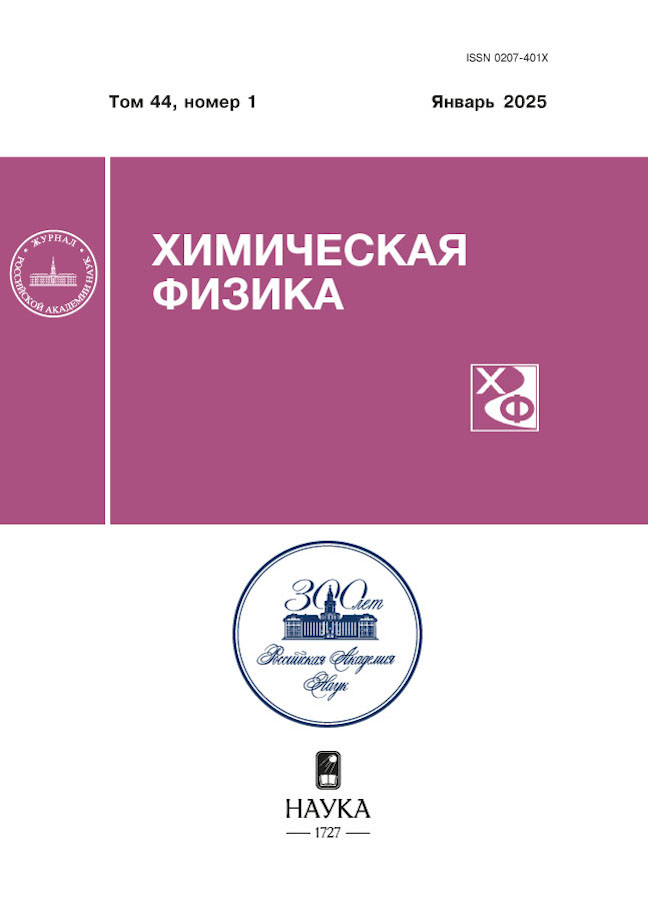Features of interpretation of pulsed radiation-induced conductivity of polymers at low temperature
- Авторлар: Mullakhmetov I.R.1, Saenko V.S.1, Tyutnev A.P.1, Pozhidaev E.D.1
-
Мекемелер:
- National Research University Higher School of Economics
- Шығарылым: Том 44, № 1 (2025)
- Беттер: 77-83
- Бөлім: Электрические и магнитные свойства материалов
- URL: https://medjrf.com/0207-401X/article/view/683324
- DOI: https://doi.org/10.31857/S0207401X25010083
- ID: 683324
Дәйексөз келтіру
Аннотация
The pulsed radiation-induced conductivity of polyethylene and polypropylene was studied at low (about 100 K) temperatures under the influence of electron pulses with an energy of 50 keV and a duration of 1 ms. To explain the results obtained, the Rose-Fowler-Vaisberg model was used. It is shown that when using it, it is necessary to take into account the difference in the shifts of carriers in a unit electric field before the first trapрing and those moving by recapture along traps appearing in the theoretical Rose–Fowler–Vaisberg model. Both of these parameters were calculated based on the results of experimental results.
Толық мәтін
Авторлар туралы
I. Mullakhmetov
National Research University Higher School of Economics
Хат алмасуға жауапты Автор.
Email: sseew111@gmail.com
Tikhonov Moscow Institute of Electronics and Mathematics
Ресей, MoscowV. Saenko
National Research University Higher School of Economics
Email: sseew111@gmail.com
Tikhonov Moscow Institute of Electronics and Mathematics
Ресей, MoscowA. Tyutnev
National Research University Higher School of Economics
Email: sseew111@gmail.com
Tikhonov Moscow Institute of Electronics and Mathematics
Ресей, MoscowE. Pozhidaev
National Research University Higher School of Economics
Email: sseew111@gmail.com
Tikhonov Moscow Institute of Electronics and Mathematics
Ресей, MoscowӘдебиет тізімі
- A.P. Tyutnev, V.S. Saenko, E.D. Pozhidaev, N.S. Kostyukov, Dielectric properties of polymers in fields of ionizing radiation (Nauka, Moscow, 2005). [in Russian].
- A.P. Tyutnev, V.N. Abramov, P.I. Dubenskov, A.V. Vannikov, V.S. Saenko, Reports of the USSR Academy of Sciences. 289 (6), 1437 (1986).
- A.P. Tyutnev, D.N. Sadovnichiy, V.S. Saenko, E.D. Pozhidaev. Polymer Science, Series A. 47 (11), 1971 (2005).
- А.P. Tyutnev, V.S. Saenko, R.Sh. Ikhsanov, E.A. Krouk. J. Appl. Phys. 126, 095501 (2019). https://doi.org/10.1063/1.5109768
- A.P. Tyutnev, R.Sh. Ikhsanov, V.S. Saenko, E.D. Pozhidaev. Polymer Science, Series A. 48 (11), 2015 (2006).
- A.P. Tyutnev, V.S. Saenko, I.R. Mullakhmetov, A.E. Abrameshin. J. Appl. Phys. 129, 175107 (2021). https://doi.org/10.1063/5.0048649
- I.R. Mullakhmetov, A.P. Tyutnev, V.S. Saenko, E.D. Pozhidaev. Technical Physics. 93 (1), 130 (2023). https://doi.org/10.21883/JTF.2023.01.54072.207-22
- A.P. Tyutnev, V.S Saenko, I.R. Mullakhmetov, A.E Abrameshin. J. Appl. Phys. 132, 135105 (2022). https://doi.org/10.1063/5.0106159
- A.P. Tyutnev, V.S. Saenko, I.R. Mullakhmetov, E.D. Pozhidaev. J. Appl. Phys. 134, 095903 (2023). https://doi.org/10.1063/5.0158855
- V.I. Gol’danskij, L.I. Trahtenberg, V.N. Flerov. Tunnel phenomena in chemical physics (Nauka, Moscow, 1986). [in Russian].
- A.P. Tyutnev, V.S. Saenko, E.D. Pozhidaev. Khim. fizika 25 (1), 79 (2006).
- A.P. Tyutnev, V.S. Saenko, E.D. Pozhidaev. IEEE Transactions on Plasma Science. 46 (3), 645 (2018). https://doi.org/10.1109/TPS.2017.2778189
- A.P. Tyutnev, D.N. Sadovnichii, V.S. Saenko, E.D. Pozhidaev. Polymer Science, Series A. 42 (1), 16 (2000).
- G.M. Bartenev, A.G. Barteneva. Relaxation properties of polymers (Khimiya, Moscow, 1992) [in Russian].
- V.R. Nikitenko. Non-stationary processes of transfer and recombination of charge carriers in thin layers of organic materials (NRNU MEPhI, Moscow, 2011). [in Russian].
- M.D. Khan, V.R. Nikitenko, A.P. Tyutnev, R.Sh. Ikhsanov. J. Phys. Chem. C. 123 (3), 1653 (2019). https://doi.org/10.1021/acs.jpcc.8b11520
- L.V. Lukin. Russ. J. Phys. Chem. B. 17 (6), 1300 (2023). https://doi.org/10.1134/S1990793123060180
- L.V. Lukin // Russ. J. Phys. Chem. B. 18 (6) (2024).
- G. N. Gerasimov, V. F. Gromov, M. I. Ikim et al. Russ. J. Phys. Chem. B. 15 (6), 1102 (2021). https://doi.org/10.1134/S1990793121310018
- G. V. Simbirtseva, S. D. Babenko. Russ. J. Phys. Chem. B. 17 (6), 1309 (2023). https://doi.org/10.1134/S1990793123060222
Қосымша файлдар














